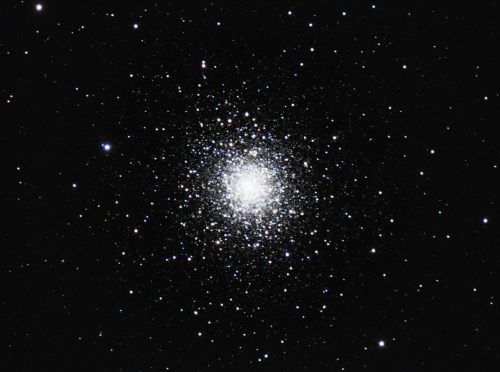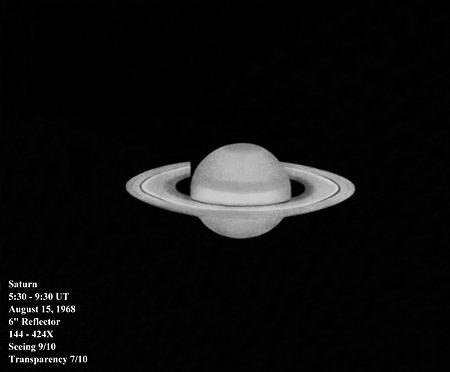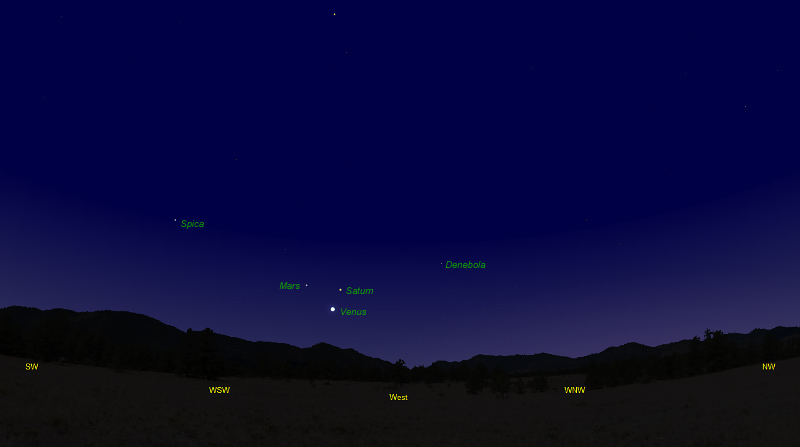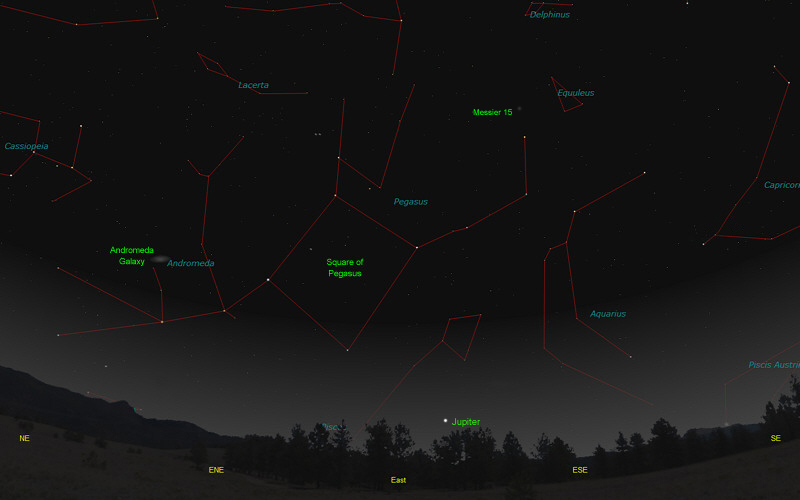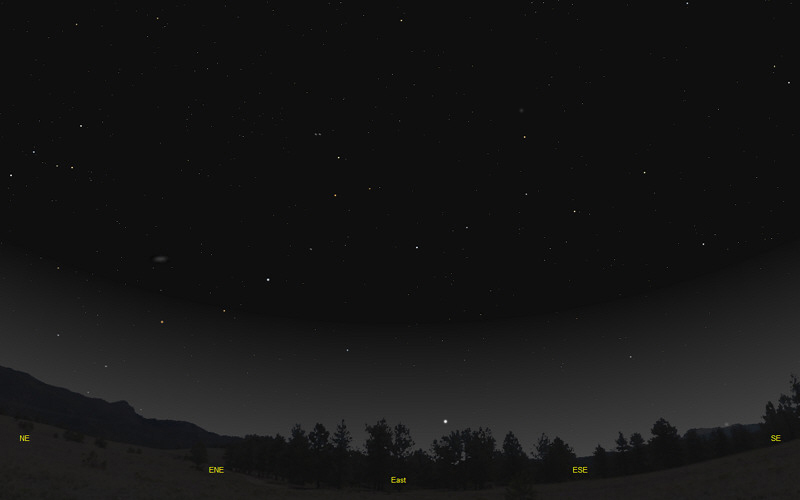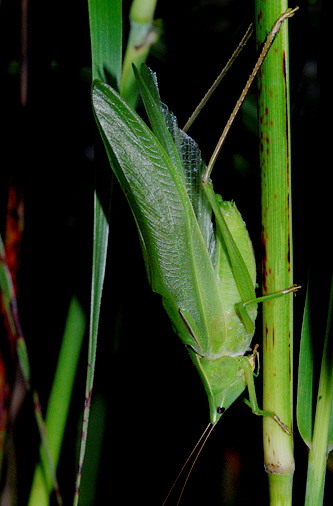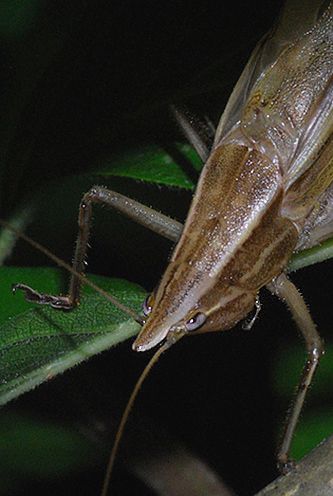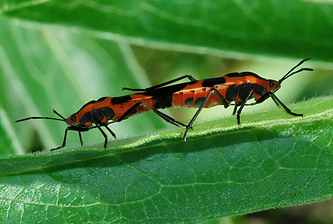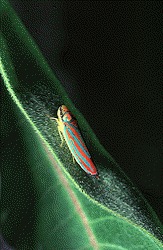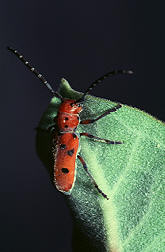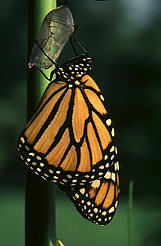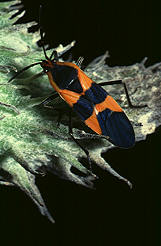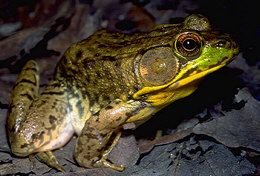The purpose of this feature is to give scout leaders, educators and naturalists an idea of some of the natural events coming up each month. We will try to cover a variety of natural events ranging from sky events to calling periods of amphibians, bird and mammal watching tips, prominent wildflowers and anything else that comes to mind. We will also note prominent constellations appearing over the eastern horizon at mid-evening each month for our area for those who would like to learn the constellations. If you have suggestions for other types of natural information you would like to see added to this calendar, let us know! Note: You can click on the hyperlinks to learn more about some of the featured items. To return to the Calendar, hit the "back" button on your browser, NOT the "back" button on the web page. All charts are available in a "printer friendly" mode, with black stars on a white background. Left clicking on each chart will take you to a printable black and white image. Please note that images on these pages are meant to be displayed at 100%. If your browser zooms into a higher magnification than that, the images may lose quality. Though we link book references to nationwide sources, we encourage you to support your local book store whenever possible. Notes and Images From July 2010
We took this image of the globular cluster Messier 92 on the evenings of July 14th and July 15th. Both nights were extremely hot and humid, with the temperature around 88 degrees Fahrenheit at 10:00pm. The cluster was high overhead in Hercules. At the telescope we were immersed in a sea of insect sounds; Common True Katydids, Oblong-winged Katydids, Common Meadow Katydids, crickets, Robust and Nebraska Coneheads, all playing their songs in a full volume midsummer concert. Imaging began around 11:30pm on both evenings and continued till dawn. We started the imaging runs and then went to bed, leaving the telescope's control software to sort through the passing clouds. The brighter stars of the M92 are yellowish, but there are many fainter blue stars visible. The blue stars give the cluster a photographically "cool" appearance. It looks a little like a stellar snow cone, a cool treat on a hot summer night. Messier 92 was discovered on December 27th, 1777 by Johann Bode and independently rediscovered by Messier on March 18th, 1781. It is around 26,000 light-years distant, with a diameter of 109 light-years. M92 is one of around 150 globular clusters found in the halo of our Milky Way Galaxy.
Beneath the great summer starscapes many small creatures prowl the night. We imaged this Two-Striped Planthopper, Acanalonia bivittata, on July 21st. Shown is the nymph phase of this species. The body is only about an eighth of an inch long, and the white plume behind the body adds an additional eighth of an inch. In size it is more than 10 to the twentieth power, or 100 billion billion times, smaller than the globular cluster Messier 92.
Planthoppers feed on a variety of plants and are a commonly found foraging on summer evenings. They are classified in the infraorder Fulgoramorpha. The nymphs of many species exude a waxy substance from special glands in the abdominal area. These waxy strands, which can be seen in the images, form a plume behind the nymphs and may help in concealment. The name "planthopper" comes from the remarkable way the adults mimic the appearance of small leaves and foliage. For a view of an adult Conehead Planthopper you can view the Natural Calendar for August of 2009. For more on insects see the section on insects below.
When I was in high school many years ago I made a 6 inch reflecting telescope. Many hours were spent in grinding, polishing and figuring the 6 inch mirror in the basement of our house in Knoxville. Figuring is the process of taking the polished surface of the mirror and transforming it into an accurate parabola. It is something of an art, and takes a lot of experience to do well. After using the telescope for a while, I decided to have the mirror refigured by Cave Optical Company. They put a beautiful optical surface on the mirror, and it was well worth the then princely sum of $42.00 that I paid them. Looking for a small, kid-friendly telescope recently for a summer camp astronomy program at the Owl's Hill Nature Sanctuary, I spotted the old scope hanging on the wall of our basement. I had not looked through it for over 37 years. Remembering the crisp views of the planets that this scope had delivered, I decided to do a little refurbishing. I carefully removed the optical components and cleaned them, cleaned and repainted the tube assembly inside and out, and reassembled the scope. I mounted the tube assembly on a new automated "go to" mounting I have and took it out beneath the stars. The scope performed incredibly well. It's views of Saturn and Mars were stunningly sharp at high power. No visible flaws could be seen when star testing the optics. But the final test came on the night of the program. As the campers looked at the "real" Saturn there were a lot of "Wows!" and "Cools!" For an amateur astronomer, there are few night sounds as pleasing. Since those long bouts of mirror grinding in the basement in Knoxville, Saturn has completed one full 30-year orbit around the Sun and part of another. The six inch reflector has followed me through many apartments, houses and changes in my life. But it still brings wonder, now to a new generation.
Sky Events for August 2010: The Perseid Meteor Shower peaks in the morning hours of August 13th, though the peak is broad and you could see activity on the previous night. Conditions should be favorable with the moon absent from the morning sky. Prime viewing time is from around midnight until dawn. A couple of lounge chairs and a blanket make viewing more comfortable. Evening Sky: Venus, Mars and Saturn form a triangle in the western sky at dusk at the beginning of the month. Venus is by far the brightest of the three planets and will appear after sunset before any other star or planet. The three planets are closest on the evening of August 7th. The view below shows the view about one hour after sunset on the 7th.
Jupiter rises about 10:16pm on the first of the month, although you will want to view it in the early morning hours to get the best telescopic view. The normally prominent south equatorial belt has faded in the last few months, and is now no longer visible. For those of us so used to seeing two dark equatorial belts, the planet looks a bit unusual. All times noted in the Sky Events are for Franklin, Tennessee and are Central Daylight Time. These times should be pretty close anywhere in the mid-state area. Constellations: The views below show the sky looking east at 10:00pm CDT on August 15th. The first view shows the sky with the constellations outlined and names depicted. Star and planet names are in green. Constellation names are in blue. The second view shows the same scene without labels. New constellations this months are Pegasus, the Flying Horse, Andromeda, Princess Andromeda, Triangulum, the Triangle, Pisces, the Fishes, and Aquarius, the Water Bearer. Note bright Jupiter low in the east in Pisces.
Find the "Square of Pegasus" and work your way outward from it to the constellations around it. See if you can pick out the faint glow of the Andromeda Galaxy, over 2 million light years away! When you look at this galaxy you're seeing light that began its journey to us in the Pleistocene epoch. To get the best look, wait until the galaxy climbs high in the sky. The Andromeda Galaxy was first shown on star charts prepared in 905AD by the Persian astronomer, Al Sufi, and was referred to as the "Little Cloud." That well describes its appearance to the naked eye. Binoculars will greatly improve your view, as will driving out of the city and finding darker skies. Simon Marius, in 1610, was among the first to observe the Andromeda Galaxy through a small telescope. He compared its soft glow to "the light of a candle shining through horn." In dark skies, those using small telescopes may pick out the small satellite galaxies M32 (above and left of the nucleus of M31 in the above image) and NGC 205 (below). If you have success with the Andromeda Galaxy, you might want to try a binocular tour of some of the bright Messier globular clusters, like M-92, that are so prominent this time of year. You will want a dark country sky to do this, and you will need a star atlas (see references below).
On Learning the Constellations: We advise learning a few constellations each month, and then following them through the seasons. Once you associate a particular constellation coming over the eastern horizon at a certain time of year, you may start thinking about it like an old friend, looking forward to its arrival each season. The stars in the evening scene above, for instance, will always be in the same place relative to the horizon at the same time and date each August. Of course, the planets do move slowly through the constellations, but with practice you will learn to identify them from their appearance. In particular, learn the brightest stars for they will guide you to the fainter stars. Once you can locate the more prominent constellations, you can "branch out" to other constellations around them. It may take you a little while to get a sense of scale, to translate what you see on the computer screen or what you see on the page of a book to what you see in the sky. Look for patterns, like the stars that make up the "Square of Pegasus." The earth's rotation causes the constellations to appear to
move across the sky just as the sun and the moon appear to do. If you go
outside earlier than the time shown on the charts, the constellations will be
lower to the eastern horizon. If you observe later, they will have climbed
higher. As each season progresses, the earth's motion around the sun
causes the constellations to appear a little farther towards the west each night
for any given time of night. If you want to see where the constellations
in the above figures will be on September 15th at 10:00pm CDT, you can stay up
till midnight on August 15th and get a preview. The westward
motion of the constellations is equivalent to two hours per month. Recommended: Sky & Telescope's Pocket Star Atlas is beautiful, compact star atlas. It is destined to become a classic, and is a joy to use at the telescope. A good book to learn the constellations is Patterns in the Sky, by Hewitt-White. You may also want to check out at H. A. Rey's classic, The Stars, A New Way to See Them. For skywatching tips, an inexpensive good guide is Secrets of Stargazing, by Becky Ramotowski. A good general reference book on astronomy is the Peterson
Field Guide,
A Field Guide to the Stars and Planets, by Pasachoff. The book retails for around $14.00. Starry Night has several software programs for learning the night sky. Visit the Starry Night web site at www.starrynight.com for details.
Insects: Late summer is the time of the great insect orchestras. Cicadas are heard during the day and at dusk, and Common True Katydids evoke memories of past summer evenings with their familiar music. And at this time of year, it would be hard to drive a back country road and not hear the raspy song of a conehead.
Two common species of coneheads in Tennessee are the Robust Conehead and the Nebraska Conehead. Both species can be either green or a brown in color. Both usually call from weedy vegetation with their head down, as shown in the image at right, ready to drop into the ground cover if alarmed. Coneheads are in the katydid family (Tettigoniidae), which also includes the True Katydids, the Meadow Katydids, the Shieldback Katydids and the False Katydids. The genus is Neoconocephalus. The easiest way to locate coneheads is by listening for their calls. Just drive a few back roads that pass by weedy fields at dusk or later and you should hear them. The Robust Conehead is the larger of the two species and is between two and three inches long. It has a very long, rasping call on one pitch. Like a bad musician, it seems to try to make up in sheer volume what its song lacks in complexity. As you drive by you can sometimes hear the call doppler-shifting downward. The call has a peak frequency of around 8 kHz, and you can listen to one I recorded by clicking here. There are two cuts - the first cut records the sound as you might hear it at a distance, and includes Common True Katydids in the background. The second cut records the sound as you might hear it if one is calling right beside the road. The name Nebraska Conehead is a little misleading, as the range of this species also includes a wide area of the eastern United States. A little smaller than the Robust Conehead, it measures between 1-3/4 inches to 2-1/4 inches in length. The call of the Nebraska Conehead is also a raspy note on one pitch, but the length of each call last only between 1-1/2 to 2 seconds, with a pause of about one second in between calls. Its call peaks around 10 kHz. To listen to a recording of a Nebraska Conehead that we made last summer, click here. Seen close up, the eyes of both species are quite interesting. If you happen across a conehead that is not calling, look carefully at the underside of the cone and observe how it is marked. These markings are a useful way to distinguish between species. See the reference at the bottom of this section for help in identification.
By day, some of the more colorful insects can be found in
patches of milkweed.
Monarch butterflies lay their tiny cream-colored
eggs on the milkweed leaves
and you can usually find a Monarch caterpillar munching on the foliage. If you’re lucky, you might even find the
beautiful, jewel-like chrysalis of the Monarch nearby. To see a complete image sequence of a Monarch caterpillar forming it's chrysalis
and emerging as a butterfly,
click
here. Scarlet and Green Leafhoppers, Large
Milkweed Bugs and Red Milkweed Beetles all add their brilliant warning colors
to the scene.
To learn more about insects and insect songs we recommend: The Songs of Insects, by Lang Elliott & Will Hershberger (Houghton Mifflin) - Beautifully written and including many spectacular images, this book includes an audio CD and detailed range maps. It was a real bargain for $19.95, and you can now get it from Amazon for less than $14.00.
Amphibians:
Listen for Cope's Gray Treefrogs, Gray Treefrogs, Bird-Voiced Treefrogs, Green Treefrogs and Barking Treefrogs. Northern Cricket Frogs and Southern Cricket Frogs are still calling, as are American Bullfrogs and Green Frogs. Spring Peepers have a much higher, shorter call this time of year. On cooler nights listen for American Toads. After heavy rains listen for the high, insect-like call of the Eastern Narrow-mouthed Toad and the strange-sounding Eastern Spadefoot.
Archives (Remember to use the back button on your browser, NOT the back button on the web page!) Natural Calendar February 2010 Natural Calendar December 2009 Natural Calendar November 2009 Natural Calendar September 2009 Natural Calendar February 2009 Natural Calendar December 2008 Natural Calendar November 2008 Natural Calendar September 2008 Natural Calendar February 2008 Natural Calendar December 2007 Natural Calendar November 2007 Natural Calendar September 2007 Natural Calendar February 2007 Natural Calendar December 2006 Natural Calendar November 2006 Natural Calendar September 2006 Natural Calendar February 2006
Natural Calendar
December 2005
Natural Calendar
November 2005
Natural Calendar
September 2005
Natural Calendar
February 2005
Natural Calendar
December 2004
Natural Calendar
November 2004
Natural Calendar
September 2004
Natural Calendar
February 2004
Natural Calendar
December 2003
Natural Calendar
November 2003
Natural Calendar
September 2003 Natural Calendar February 2003 Natural Calendar December 2002 Natural Calendar November 2002 Nature Notes Archives: Nature Notes was a page we published in 2001 and 2002 containing our observations about everything from the northern lights display of November 2001 to frog and salamander egg masses. Night scenes prepared with The Sky Professional from Software Bisque. All images and recordings © 2010 Leaps |
||||||||||||||||||||||||||||||
